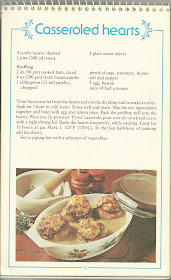Before 1935 it was impossible for you to have a heart
attack. Not because such things did not exist — but because they weren’t called
that. People only started calling them heart attacks in 1935. Of course, they
might have been referring to this recipe, which some might consider an attack
of hearts. You might think that people ate more hearts back then, but you’d be
wrong: you probably eat just as many hearts now, only in hot dogs rather than
stuffed whole ones like these.
Before the 1930s, you could not be accused of being a
“bleeding heart” because before that the phrase referred to a flowering plant,
rather than an excess of sympathy. Being shot through the heart would certainly
cause excessive bleeding (and also death), but it wouldn’t necessarily give
love a bad name unless it appears in a song by Bon Jovi. Love has long been
thought to reside in the heart, the heart itself represented by the symbol <3.
Some people love Bon Jovi. Some <3 NY.
Literally speaking, love cannot lie bleeding, though there
is a plant (amaranthus caudatus)
whose common name is love-lies-bleeding. Its flowers look like spilled guts.
You’d get spilled guts if the person shooting you through the heart aimed too
low. Cupid, a cherub, is typically held responsible for shooting an arrow
through lover’s hearts in a grotesque parody of reverse conception in which the
product of the lover’s love results in a baby. Cupid is the Roman counterpart
of Eros, the Greek god of love. Eros spelled backward is “sore,” which is what
you’d be if someone shot an arrow through your chest.
If you are in love, you might say your heart is full —
bursting with joy — as opposed to being stuffed full of cooked ham and
breadcrumbs, as in this recipe. If your heart is stuffed full of ham and
breadcrumbs, there is something grievously wrong with your digestive tract and
you should see a doctor immediately. While waiting, you may be subjected to
muzak (Bon Jovi, perhaps), which is not to be mistaken for music, which Shakespeare
tells us is “the food of love.” Music isn’t the food of love, but these
Casseroled Hearts almost certainly are.
Play on.
The ‘Pyrex’ Book of
Regional Cookery, Diana Cameron-Shea, 1977

